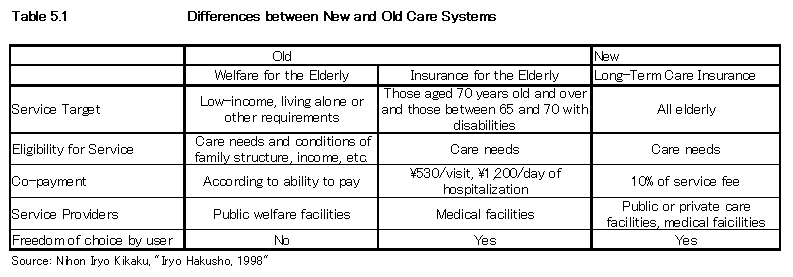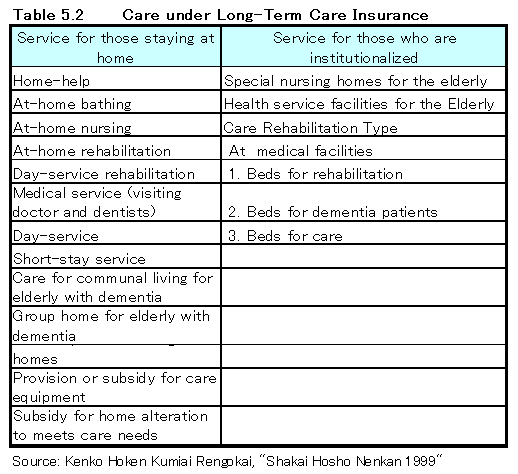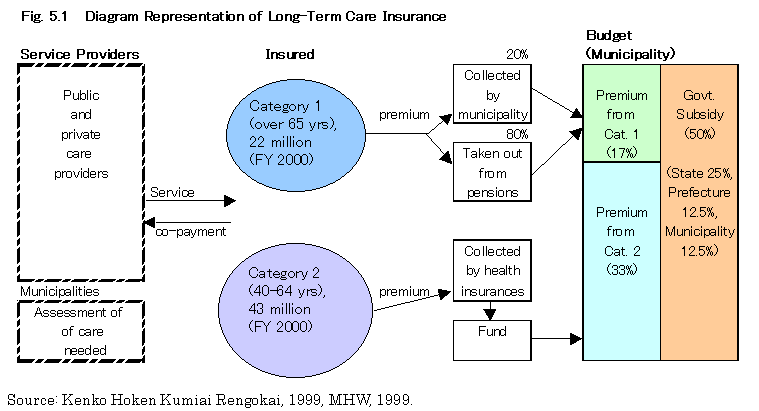
Starting in April 2000, Japan will introduce Long-Term Care Insurance. The insurance system will replace the long-term care portion of medical service for the elderly, that was provided partly through health insurance system and partly by the welfare measures. The main differences between the Long-Term Care Insurance and long-term care provided by the existing systems are shown in Table 5.1. The new system grew out of the recognition that the care need of an aging society has become a huge financial burden on the health insurance system and such arrangement will sure be unsustainable in the future. Furthermore, due to changes in the society such as weakened community ties, increase in small-sized families, and increase in working women, financial and psychological burden of family in the face of care for the elderly has become unbearably large. The Long-Term Care Insurance is designed to share the burden of caring for the elderly among all members of the society and less! en the burden of the family. In other words, it aims to establish a system that responds to society's major concern about aging, and to assure the citizens that they will receive care, if necessary, and be supported by society as a whole.

a)Å@Insured
The insured persons are those who are aged 65 and over (Category 1) and those between ages of 40 to 64 and are subscribers of health insurance (Category II). The premium is collected through municipality and deducted from pensions for the Category I, and through additional premium to be paid to health insurance for the Category II. Premium amount is determined by each municipality, and thus differs depending on available facilities and demand for care service . Premium is income-related, and there will be moderating measures for low-income insured.
b)Å@Service provided
A list of care services is shown in Table 5.2. The services are provided both at home and at institutions depending on the care required by user. The user is free to choose the kind of care and its providers, which can be either public or private. However, the degree of required care must be assessed beforehand by the municipality of user's residence.
c)Å@Source of financing
The cost incurred in the Long-Term Care Insurance is financed 50% by premiums (17% by Category I, 33% by Category II) and 50% by government subsidy. Within this framework the municipality can determine the rate of premium for the insured of Category 1. It is estimated about 3,000 yen per month on average. For the Category 2 insured the rate will be 0.95% of salary in the Government-managed Health Insurance and 0.88% in the Association-managed Health Insurance.


One of the concerns in introducing the Long-Term Care Insurance is uneven distribution of care facilities throughout Japan, resulting in a shortage of care providing facilities, both private and public, in some regions. The anxiety is expressed, "Insurance, but no Service". The government has formed a plan to increase the public care facilities and to encourage private sector to enter into the field.
At the same time, there is also a concern about the quality of care provided by the private sector. The quality control measures need to be set.
2.Response to the rise of insurance premiumAnother issue is the amount of premium. For the insured of the Category I the premium is deducted from pensions or collected separately by the municipality, and for the Category II the amount of health insurance premium will be increased. There is also a considerable variation in the premium among municipalities. At the end of 1999, the Government has decided to reduce the amount of premium by 100% for the first 6 months and by 50% for the next year for the Category I, and provide subsidy worth 1 year of increased amount for the Category II, to have some "ease-off period". However, this measure will require an additional government budget, and has drawn fierce criticisms.
3.Cash Allowance for caring familyLastly, whether or not to provide cash allowance for those choosing to care for the elderly by family is a contentious issue. There are pros and cons based on the evaluation of the traditional family care giving. At the end of 1999, the Government has decided, as a temporary two-year measure, to provide the yearly maximum of \100,000 per elderly to a municipality which decides to give assistance to those who choose family care.